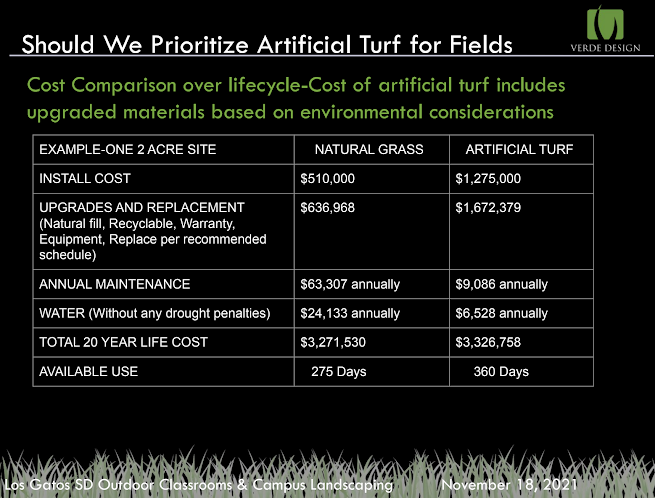Plastic grass fields won't save LGUSD money!
LGUSD management staff have concluded plastic grass fields will NOT save the district money over reconstructed, properly maintained natural grass fields.
LGUSD management staff, by their own admission, have not chosen to prioritize adequate maintenance of fields for years. Current field conditions do not reflect limitations in the ability to properly maintain natural grass fields; They simply reflect neglect.
If natural grass is chosen for fields, the district's proposal is for the fields to be completely renovated: leveled, properly drained, outfitted with with modern, efficient irrigation, re-sodded and staffed with adequate labor for maintenance.
As shown in the slide below, LGUSD staff compared the 20-year cost of its proposal to reconstruct natural grass fields and begin adequately maintaining and watering them against the cost of plastic grass (a.k.a. artificial turf).
LGUSD staff concluded plastic grass does NOT save money.
Over 20 years, the district expects it would cost ~$3.3 million to install and adequately maintain a single field, regardless of whether it is natural grass or plastic grass.
The case for plastic grass is NOT compelling.
Caution: do not be swayed by the "Available Use" comparison.
Plastic fields are much like paved surfaces... they add to urban heat islands and their heat can be detrimental to the kids that spend time on them. The primary users of these fields are K-5 students. They need, now more than ever, the mental health benefits that come with authentic nature. If these outdoor surfaces at our schools become primarily asphalt and plastic when all is said and done, the children will have many days with no escape from the heat during lunch recess and in early afternoon. The heat from plastic grass will be miserable. Yet in the table above, these days are misleadingly counted by the district among artificial turf's "usable" days for our schoolkids, artificially inflating the appeal of plastic grass. Even the district's landscape designer, when asked about this figure, conceded that on hot days, teachers may want to schedule their use of turf for earlier in the day.
The other glaring issue on the topic of "Available Use" is that if the $1.2 million in funds needed for replacement of carpet and infill every 8 years are not available, artificial turf won't just become unusable for sports leagues. It will become unusable for students during the school day, i.e. for the district's primary users.
An abandoned plastic grass field becomes a petrochemical dump. In contrast, an abandoned natural grass field becomes a meadow and will continue to be a usable playground. Mow down that meadow and the fields would still be in better condition than the fields our children are using today, conditions the district has considered safe enough for our kids to play on for many years.
In other words, "Available Use" needs to factor in full school days and years when funds for maintenance run low.
Again, the case for plastic grass is NOT compelling.
